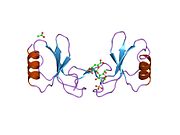CCL5
Ensembl | |||||||||
|---|---|---|---|---|---|---|---|---|---|
| UniProt | |||||||||
| RefSeq (mRNA) | |||||||||
| RefSeq (protein) | |||||||||
| Location (UCSC) | Chr 17: 35.87 – 35.88 Mb | Chr 11: 83.42 – 83.42 Mb | |||||||
| PubMed search | [3] | [4] | |||||||
| View/Edit Human | View/Edit Mouse |
Chemokine (C-C motif) ligand 5 (also CCL5) is a protein which in humans is encoded by the CCL5 gene.[5] The gene has been discovered in 1990 by in situ hybridisation and it is localised on 17q11.2-q12 chromosome.[6] It is also known as RANTES (regulated on activation, normal T cell expressed and secreted). RANTES was first described by Dr. Tom Schall who named the protein, the original source of the name Rantes was from the Argentine movie Man Facing Southeast about an alien who shows up in a mental ward who was named Rantés, the rather clunky acronym was only made to fit the name.[7]
Function
CCL5 belongs to the CC subfamily of
The chemokine CCL5 is mainly expressed by T-cells and monocytes,
CCL5 was first identified in a search for genes expressed "late" (3–5 days) after
RANTES, along with the related chemokines MIP-1alpha and MIP-1beta, has been identified as a natural HIV-suppressive factor secreted by activated CD8+ T cells and other immune cells.[10] The RANTES protein has been engineered for in vivo production by Lactobacillus bacteria, and this solution is being developed into a possible HIV entry-inhibiting topical microbicide.[19]
Interactions
CCL5 has been shown to
CCL5 also activates the G-protein coupled receptor GPR75.[25]
CCL5 has two mechanisms of action according to its concentration.
- The first one occurs at low concentration of the chemokine. CCL5 may act as a dimer. Dimerization is not necessary for binding to CCR5. Thus, CCL5 in nanomolar concentration acts as classical chemokine and binds to its receptor. For the acting as classical chemokine and for the dimerization, N terminus of the molecule is important.
- The second one occurs at high concentration of the chemokine. CCL5 creates self-aggregates binding to glycosaminoglycans (GAGs) on the cell surface. For that, Glu66 and Glu26 are important. These amino acids are presented on the protein surface and allows ion interactions. In the experiment where these molecules were exchanged for serine, the self-aggregation did not occur.[26] In vitro, the self-aggregates are strong activators of leukocytes. They can act as mitogens and they are not dependent on binding to the receptor. Activated T-cells (or other cells, for instance monocytes or neutrophils) either proliferate or perform apoptosis, and they release proinflammatory cytokines, such as IL-2, IL-5 and IFN-γ.[8] CCL5 mediated apoptosis in T-cells includes release of cytochrome c in cytoplasm and the activation of caspase-9 and caspase-3. The apoptosis is dependent on GAGs binding on cell surface and there is a requirement of at least 4 CCL5 molecules to induce the apoptosis.[27]
Clinical significance
CCL5 is involved in
For instance, CCL5 level is higher during rejection of
Importance of CCL5 is proved by various microbial strategies to avoid the activity of chemokine. For instance,
Increased levels of CCL5 was discovered in lots of cancers. For instance in breast cancer,[28] hepatocellular carcinoma,[6] stomach cancer, prostate cancer and pancreatic cancer.[11]
CCL5 plays an important role in various human disorders, such as atherosclerosis, COVID-19, SARS,[11] atopic dermatitis, asthma, glomerulonephritis,[8] alcohol liver disease, acute liver failure and viral hepatitis.[6]
See also
References
- ^ a b c ENSG00000274233 GRCh38: Ensembl release 89: ENSG00000271503, ENSG00000274233 – Ensembl, May 2017
- ^ a b c GRCm38: Ensembl release 89: ENSMUSG00000035042 – Ensembl, May 2017
- ^ "Human PubMed Reference:". National Center for Biotechnology Information, U.S. National Library of Medicine.
- ^ "Mouse PubMed Reference:". National Center for Biotechnology Information, U.S. National Library of Medicine.
- PMID 1691736.
- ^ S2CID 212858919.
- ^ Cohen P (14 December 1996). "Hooked on HIV - What's the connection between a 1980s film character and the cutting edge of AIDS research? Philip Cohen reports on a protein that's unlocking HIV's mysteries". Copyright New Scientist Ltd.
- ^ PMID 11286708.
- S2CID 25389419.
- ^ S2CID 84062618.
- ^ PMID 34514075.
- ^ PMID 17322928.
- S2CID 41891558.
- ISBN 978-1-57059-253-9.
- PMID 10023774.
- S2CID 30184294.
- S2CID 1190644.
- PMID 12433367.
- PMID 20479208.*Lay summary in: American Society for Microbiology (July 24, 2010). "Microbicide containing engineered bacteria may inhibit HIV-1". Science Daily.
- PMID 8642344.
- ^ PMID 11449371.
- PMID 14637022.
- ^ PMID 11116158.
- PMID 22265023.
- PMID 17001303.
- PMID 10488085.
- PMID 16807236.
- ^ PMID 23376885.
- PMID 21814510.
External links
- Human CCL5 genome location and CCL5 gene details page in the UCSC Genome Browser.
- Overview of all the structural information available in the PDB for UniProt: P13501 (C-C motif chemokine 5) at the PDBe-KB.
Further reading
- Muthumani K, Desai BM, Hwang DS, Choo AY, Laddy DJ, Thieu KP, et al. (April 2004). "HIV-1 Vpr and anti-inflammatory activity". DNA and Cell Biology. 23 (4): 239–247. PMID 15142381.
- Zhao RY, Elder RT (March 2005). "Viral infections and cell cycle G2/M regulation". Cell Research. 15 (3): 143–149. PMID 15780175.
- Zhao RY, Bukrinsky M, Elder RT (April 2005). "HIV-1 viral protein R (Vpr) & host cellular responses". The Indian Journal of Medical Research. 121 (4): 270–286. PMID 15817944.
- Li L, Li HS, Pauza CD, Bukrinsky M, Zhao RY (2006). "Roles of HIV-1 auxiliary proteins in viral pathogenesis and host-pathogen interactions". Cell Research. 15 (11–12): 923–934. PMID 16354571.
- Ignatov A, Robert J, Gregory-Evans C, Schaller HC (November 2006). "RANTES stimulates Ca2+ mobilization and inositol trisphosphate (IP3) formation in cells transfected with G protein-coupled receptor 75". British Journal of Pharmacology. 149 (5): 490–497. PMID 17001303.









